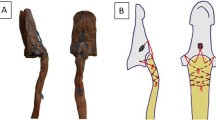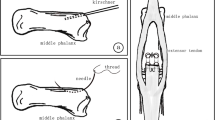Abstract
Introduction
The objective of this retrospective review was to evaluate the functional and esthetic outcomes in patients with non- or minimally (<2 mm), and severely (>2 mm) displaced bony avulsions of the flexor digitorum profundus (FDP) tendon.
Materials and methods
Between 1996 and 2010, 29 patients with a bony avulsion of the FDP tendon were treated. The displacement magnitude of the avulsed fragment determined, whether conservative or surgical treatment was performed. Persisting functional deficit, radiological findings, remaining disabilities using the Disability of the Arm, Shoulder, and Hand (DASH) score, as well as treatment-related deformities and complications were evaluated retrospectively and at a mean follow-up of 7 years.
Results
In 16 patients, conservative therapy by initial static splinting due to a fragment displacement of <2 mm was conducted. These patients reported no functional impairment at follow-up. In 13 cases, major displacement (>2 mm) of the bony fragment led to an open reconstruction of the avulsion injury either by screw fixation or a Lengemann pull-out wire. In a majority, an extension deficit in the DIP joint and a decrease of tip pinch strength by 25% was present at follow-up. In five patients, peri- or short-term postoperative complications occurred and in five, a nail deformity remained. DASH score revealed satisfying results after both therapeutic approaches.
Conclusions
Conservative treatment in non- or minimally displaced avulsions leads to satisfying functional results. Patients receiving surgery after major fragment displacement need to be aware of a possible impaired ROM at the DIP joint. The use of the Lengemann pull-out wire may place patients at an increased complication risk and frequently induces nail deformities.
Level of evidence
Therapeutic, level IV.





Similar content being viewed by others
References
Leddy JP, Packer JW (1977) Avulsion of the profundus tendon insertion in athletes. J Hand Surg Am 2(1):66–69
Leddy JP (1985) Avulsions of the flexor digitorum profundus. Hand Clin 1(1):77–83
McMaster PE (1933) Tendon and muscle ruptures: Clinical and experimental studies on the causes and locations of subcutaneous ruptures. J Bone Joint Surg 15:705–722
Mansat M, Bonnevialle P (1985) Traumatic avulsion of the flexor digitorum profundus tendon. Report of nineteen cases. Ann Chir Main 4(3):185–196
Leversedge FJ, Ditsios K, Goldfarb CA et al (2002) Vascular anatomy of the human flexor digitorum profundus tendon insertion. J Hand Surg Am 27(5):806–812
Becker H (1978) Primary repair of flexor tendons in the hand without immobilisation-preliminary report. Hand 10(1):37–47
Cullen KW, Tolhurst P, Lang D et al (1989) Flexor tendon repair in zone 2 followed by controlled active mobilisation. J Hand Surg Br 14(4):392–395
Frueh FS, Kunz VS, Gravestock IJ et al (2014) Primary flexor tendon repair in zones 1 and 2: early passive mobilization versus controlled active motion. J Hand Surg Am 39(7):1344–1350
Strickland JW, Glogovac SV (1980) Digital function following flexor tendon repair in Zone II: A comparison of immobilization and controlled passive motion techniques. J Hand Surg Am 5(6):537–543
Strickland JW (1985) Results of flexor tendon surgery in zone II. Hand Clin 1(1):167–179
Crosby CA, Wehbe MA, Mawr B (1994) Hand strength: normative values. J Hand Surg Am 19(4):665–670
Incel NA, Ceceli E, Durukan PB et al (2002) Grip strength: effect of hand dominance. Singapore Med J 43(5):234–237
Petersen P, Petrick M, Connor H et al (1989) Grip strength and hand dominance: challenging the 10% rule. Am J Occup Ther 43(7):444–447
Kellgren JH, Lawrence JS (1957) Radiological assessment of osteo-arthrosis. Ann Rheum Dis 16(4):494–502
Changulani M, Okonkwo U, Keswani T et al (2008) Outcome evaluation measures for wrist and hand: which one to choose? Int Orthop 32(1):1–6
Trumble TE, Vedder NB, Benirschke SK (1992) Misleading fractures after profundus tendon avulsions: a report of six cases. J Hand Surg Am 17(5):902–906
Lubahn JD, Hood JM (1996) Fractures of the distal interphalangeal joint. Clin Orthop Relat Res 327:12–20
Becker H, Orak F, Duponselle E (1979) Early active motion following a beveled technique of flexor tendon repair: report on fifty cases. J Hand Surg Am 4(5):454–460
Moiemen NS, Elliot D (2000) Primary flexor tendon repair in zone 1. J Hand Surg Br 25(1):78–84
Tuttle HG, Olvey SP, Stern PJ (2006) Tendon avulsion injuries of the distal phalanx. Clin Orthop Relat Res 445:157–168
Zook EG (1986) Complications of the perionychium. Hand Clin 2(2):407–427
Zook EG, Russell RC (1990) Reconstruction of a functional and esthetic nail. Hand Clin 6(1):59–68
Author information
Authors and Affiliations
Corresponding author
Ethics declarations
Conflict of interest
All listed authors have no conflicts of interest to declare.
No financial funding was obtained for this research.
Rights and permissions
About this article
Cite this article
Halát, G., Negrin, L., Erhart, J. et al. Treatment options and outcome after bony avulsion of the flexor digitorum profundus tendon: a review of 29 cases. Arch Orthop Trauma Surg 137, 285–292 (2017). https://doi.org/10.1007/s00402-016-2619-1
Received:
Published:
Issue Date:
DOI: https://doi.org/10.1007/s00402-016-2619-1




